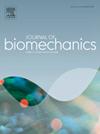Residual strains and morphometry in the human esophagus: Dependence on location, age, and gender
IF 2.4
3区 医学
Q3 BIOPHYSICS
引用次数: 0
Abstract
The esophagus is a multi-layered organ that transports food to the stomach. While extensive biomechanical data exist for animal esophagi, human data remain limited. To address this, we analyzed residual deformations and zero-stress configurations in esophageal tissue from twenty-one cadavers (aged 21-84). Rings were photographed from fifteen equidistant locations before and after radial cutting and dissection into mucosa-submucosa and muscle layers. Image analysis revealed that the opening angles of the intact wall and muscle—slightly greater for the latter—did not vary significantly along the esophagus (p > 0.05 across age groups and genders). Conversely, the mucosa-submucosa had a larger opening angle, increasing along the esophagus (p < 0.05 in young subjects and both genders). Residual strains released by radial cutting and layer separation showed no anatomical position dependence (p > 0.05). The no-load internal circumference remained age-independent (p > 0.05 at all locations), while intact-wall thickness increased from young to middle-aged subjects due to mucosa-submucosa expansion (p < 0.05 in the upper half). No significant muscle growth occurred with age. This correlated with a rise in intact-wall opening angle between those age groups (p < 0.05 at the same sites), driven by more compressive internal residual strain (p < 0.05 near mid-esophagus). Age-related variations in layer-specific opening angles and residual strains were minimal (p > 0.05 in most locations). Males had wider, thicker esophagi (p < 0.05 in the upper half), but gender had no significant effect on opening angles and residual strains. This database provides new insights into the residual strains of the human esophagus and enhances computational simulations of transport and clinical interventions.
人类食道的残余应变和形态测定:与位置、年龄和性别的关系
摘要食道是将食物输送到胃的多层器官。虽然存在大量动物食道的生物力学数据,但人类数据仍然有限。为了解决这个问题,我们分析了21具尸体(21-84岁)食管组织的残余变形和零应力结构。在径向切割和剥离粘膜下层和肌肉层之前和之后,从15个等距位置拍摄环状物。图像分析显示,完整管壁和肌肉的开口角度(后者略大)沿食道没有明显变化(p >;各年龄组和性别均为0.05)。相反,粘膜-粘膜下层开口角度较大,沿食道方向增大(p <;年轻受试者和男女均为0.05)。径向切割和分层释放的残余应变与解剖位置无关(p >;0.05)。空载内周长保持与年龄无关(p >;各部位0.05),而完好壁厚度从青年到中年受试者由于粘膜-粘膜下层扩张而增加(p <;上半部分为0.05)。随着年龄的增长,肌肉没有明显的增长。这与这些年龄组之间完整壁开口角度的增加有关(p <;0.05),由更多的压缩内部残余应变驱动(p <;食管中部附近0.05)。年龄相关的层特异性开口角和残余应变变化最小(p >;大多数地区为0.05)。男性的食管更宽、更厚(p <;上半部分0.05),性别对开口角和残余应变无显著影响。该数据库为人类食道残余应变提供了新的见解,并增强了运输和临床干预的计算模拟。
本文章由计算机程序翻译,如有差异,请以英文原文为准。
求助全文
约1分钟内获得全文
求助全文
来源期刊

Journal of biomechanics
生物-工程:生物医学
CiteScore
5.10
自引率
4.20%
发文量
345
审稿时长
1 months
期刊介绍:
The Journal of Biomechanics publishes reports of original and substantial findings using the principles of mechanics to explore biological problems. Analytical, as well as experimental papers may be submitted, and the journal accepts original articles, surveys and perspective articles (usually by Editorial invitation only), book reviews and letters to the Editor. The criteria for acceptance of manuscripts include excellence, novelty, significance, clarity, conciseness and interest to the readership.
Papers published in the journal may cover a wide range of topics in biomechanics, including, but not limited to:
-Fundamental Topics - Biomechanics of the musculoskeletal, cardiovascular, and respiratory systems, mechanics of hard and soft tissues, biofluid mechanics, mechanics of prostheses and implant-tissue interfaces, mechanics of cells.
-Cardiovascular and Respiratory Biomechanics - Mechanics of blood-flow, air-flow, mechanics of the soft tissues, flow-tissue or flow-prosthesis interactions.
-Cell Biomechanics - Biomechanic analyses of cells, membranes and sub-cellular structures; the relationship of the mechanical environment to cell and tissue response.
-Dental Biomechanics - Design and analysis of dental tissues and prostheses, mechanics of chewing.
-Functional Tissue Engineering - The role of biomechanical factors in engineered tissue replacements and regenerative medicine.
-Injury Biomechanics - Mechanics of impact and trauma, dynamics of man-machine interaction.
-Molecular Biomechanics - Mechanical analyses of biomolecules.
-Orthopedic Biomechanics - Mechanics of fracture and fracture fixation, mechanics of implants and implant fixation, mechanics of bones and joints, wear of natural and artificial joints.
-Rehabilitation Biomechanics - Analyses of gait, mechanics of prosthetics and orthotics.
-Sports Biomechanics - Mechanical analyses of sports performance.
 求助内容:
求助内容: 应助结果提醒方式:
应助结果提醒方式:


